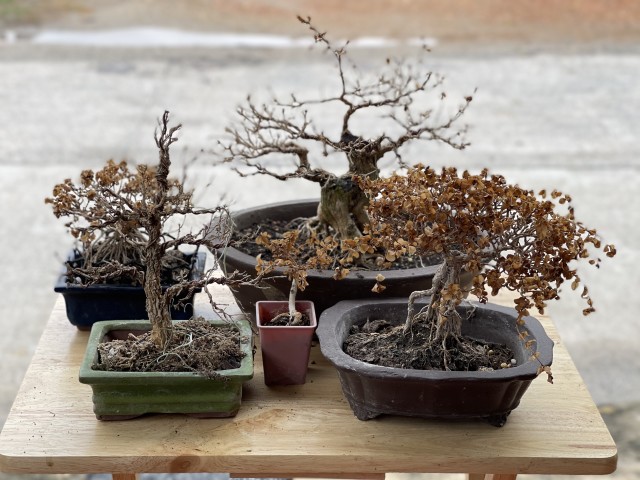It can sometimes be very difficult to tell if you’re bonsai tree is dying, but there are some things you can do to check the health of your bonsai tree and nurse it back.
First, we need to diagnose the problem and then determined what caused it. Let’s go over a few techniques to assess the health of your bonsai trees so that they will be around for years to come.
The Dying Process
First, let’s go over how bonsai trees die. The stages will vary depending on the species. This is helpful to know, so you aren’t looking for the wrong signs.
Deciduous trees usually die from the top to bottom. The leaves will first start to drop off, followed by the dying of smaller branches. Larger branches will then start to die. Eventually, the trunk itself will begin to wither, and then finally the roots.
Conifers, on the other hand, will die roots first. The root system will become sick and move up the trunk. Then branches will start to fail, and finally the foliage.
Check Your Bonsai’s Soil

What type of soil is your bonsai in? Is it well-drained? Too dry? How are the oxygen levels? These are the 3 main things to keep in mind when it comes to roots. Moisture, drainage, and oxygen! Any root system will thrive if these 3 things are kept in check.
Scratch the bark deep but enough to peel back the outer layer of bark to expose the underlying layer, called the cambium. All healthy trees will have a vibrant green cambium, so if that’s what you see, then great! If the cambium is another color, like white, brown, or grey, then that part of your tree is likely dead.
Smell the soil. It might sound strange, but you can usually detect root rot with your nose. You can try to smell the top of the soil, but make sure you smell the bottom. You can usually do this through the drainage holes on the bottom of the pot. See if you detect a rotting, sour, or sweet smell. Each smell can be an indicator of different problems all relating to root rot.
Bonsai soil is critical to ensuring the health of your bonsai tree. Improper care and your bonsai could die. Check out our Bonsai Soil Guide for more thorough information.
Scratch Test
Some trees go dormant in winter and lose all their leaves. It can be hard to tell if they are still alive or dying during this time. The scratch test is extremely useful during this time to check on your bonsai. The best thing about it, is it can be performed with just a fingernail.
There may still be hope. Continue scratching down toward the roots and hope to see green. If you have exposed roots, those are probably the next place to scratch. If you hit a green cambium before you get to the roots then the bonsai can probably be brought back, although the dead areas will have to be removed. Cut away any swollen bark or cankers under the bark.

Study the Foliage
Make sure to occasionally examine the foliage closely. Run your fingers through the leaves and look at them from different angles. Look at the leaf edges for withering. Check for discoloration, sometimes discolored leaves will be in clusters.
Leaf Discoloration
One of nature’s indicators. Foliage irregularities could be an indicator of nutrient deficiencies.
Look at more than just the leaves. You also want to look for any dry or drooping branches. Aside from the specifics, notice any irregularities that could indicate a potential issue. Then you will be able to better narrow down the problem.
Here’s our infographic on Pinterest that will help!
Check the Roots
Be careful about buying bonsai from gift shops or those mall kiosks. These are usually not taken care of properly and are on their way to death before you buy them. The most common issue with these plants are they are often only pruned on the top. The roots have been left to grow and take up too much of the pot. This is called root bound or pot bound.
Usually, the roots run out of space and end up circling the inside perimeter of the pot. They will grow in spirals, round and round.
Bonsai Pests

Bonsai, like any other plant, attract pests. While the non-bonsai version of these trees is usually resilient to pests, the dwarfed size of bonsai and their limited growing space can cause them to be more susceptible to pests and disease. It’s important to identify which of these pests your bonsai is infected with so that we can remove them effectively.
There are countless amounts of bonsai pests, but they call all be classified into 2 categories:
Insects
The best way to identify insects is visual. Look closely at your bonsai tree, and take note of any critters you see. You can check our pests chart [coming soon] and compare the images. It may help to take pictures.
Viruses & Fungi
Viruses can’t be seen with the naked eye, but their effects can. Look for leaf discoloration or dying branches. You will want to quarantine this plant so it doesn’t infect your others. Remove the damaged parts and treat them with an anti-fungal spray. Spectracide works just fine and is available at any hardware store or garden center. It’s also available on Amazon.
We cover bonsai pests thoroughly in our Bonsai Pest Guide.

